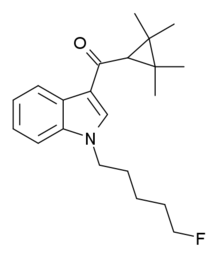 | |
| Legal status | |
|---|---|
| Legal status |
|
| Identifiers | |
| |
| CAS Number | |
| ChemSpider | |
| CompTox Dashboard (EPA) | |
| Chemical and physical data | |
| Formula | C21H28FNO |
| Molar mass | 329.459 g·mol−1 |
| 3D model (JSmol) | |
| |
| |
XLR-11 (5"-fluoro-UR-144) is a drug that acts as a potent agonist for the cannabinoid receptors CB1 and CB2 with EC50 values of 98 nM and 83 nM, respectively.[2] It is a 3-(tetramethylcyclopropylmethanoyl)indole derivative related to compounds such as UR-144, A-796,260 and A-834,735, but it is not specifically listed in the patent or scientific literature alongside these other similar compounds,[3][4] and appears to have not previously been made by Abbott Laboratories, despite falling within the claims of patent WO 2006/069196. XLR-11 was found to produce rapid, short-lived hypothermic effects in rats at doses of 3 mg/kg and 10 mg/kg, suggesting that it is of comparable potency to APICA and STS-135.[2]
Detection
A forensic standard for this compound is available, and a representative mass spectrum has been posted on Forendex.[5] An ELISA immunoassay technique for detecting XLR-11 and UR-144 in blood and urine as part of general drug screens has been developed by Randox Laboratories and Tulip Biolabs, Inc.[1][6]
Recreational use
XLR-11 was instead first identified by laboratories in 2012 as an ingredient in synthetic cannabis smoking blends, and appears to be a novel compound invented specifically for grey-market recreational use.[7] It was banned in New Zealand by being added to the temporary class drug schedule, effective from 13 July 2012.[8] It has also been banned in Florida as of 11 December 2012.[9] Arizona banned XLR-11 on April 3, 2013.[10]
Toxicity
XLR-11 has been linked to acute kidney injury in some users,[11] along with AM-2201.[12][13]
See also
References
- ^ SD HB1024
- ^ a b Attention: This template ({{cite doi}}) is deprecated. To cite the publication identified by doi:10.1021/acschemneuro.5b00107, please use {{cite journal}} (if it was published in a bona fide academic journal, otherwise {{cite report}} with
|doi=10.1021/acschemneuro.5b00107instead. - ^ WO application 2006069196, Pace JM, Tietje K, Dart MJ, Meyer MD, "3-Cycloalkylcarbonyl indoles as cannabinoid receptor ligands", published 2006-06-29, assigned to Abbott Laboratories
- ^ Frost JM, Dart MJ, Tietje KR, Garrison TR, Grayson GK, Daza AV, El-Kouhen OF, Yao BB, Hsieh GC, Pai M, Zhu CZ, Chandran P, Meyer MD (January 2010). "Indol-3-ylcycloalkyl ketones: effects of N1 substituted indole side chain variations on CB(2) cannabinoid receptor activity". J. Med. Chem. 53 (1): 295–315. doi:10.1021/jm901214q. PMID 19921781.
{{cite journal}}: CS1 maint: multiple names: authors list (link) - ^ "XLR-11". Structural, chemical, and analytical data on controlled substances. Southern Association of Forensic Scientists (SAFS).
- ^ "Randox Toxicology launches ELISA for the detection of new generation Synthetic Cannabinoids (Spice) drugs UR-144 and XLR-11". Press Release. Randox Laboratories Ltd. 29 April 2013.
- ^ Attention: This template ({{cite doi}}) is deprecated. To cite the publication identified by doi:10.1071/CH14198, please use {{cite journal}} (if it was published in a bona fide academic journal, otherwise {{cite report}} with
|doi=10.1071/CH14198instead. - ^ "CB-13, MAM-2201, AKB48, and XLR11 are classified as temporary class drugs". Temporary Class Drug Notice. The Department of Internal Affairs: New Zealand Gazette. 5 July 2012.
- ^ "Attorney General Pam Bondi Outlaws Additional Synthetic Drugs" (Press release). State of Florida. 11 December 2012.
- ^ "Governor Jan Brewer Signs Legislation to Combat Production, Use of Dangerous Drugs" (PDF) (Press release). Office of the Governor, State of Arizona. Retrieved 27 August 2014.
- ^ "Alphabet Soup, or the newer synthetic cannabinoids..." The Dose Makes The Poison Blog. 11 December 2013. Retrieved 18 September 2014.
- ^ Bhanushali GK, Jain G, Fatima H, Leisch LJ, Thornley-Brown D (April 2013). "AKI associated with synthetic cannabinoids: a case series". Clin J Am Soc Nephrol. 8 (4): 523–6. doi:10.2215/CJN.05690612. PMID 23243266.
{{cite journal}}: CS1 maint: multiple names: authors list (link) - ^ "Acute Kidney Injury Associated with Synthetic Cannabinoid Use — Multiple States, 2012". Morbidity and Mortality Weekly Report. U.S. Centers for Disease Control and Prevention (CDC). 15 February 2013. Retrieved 15 February 2013.